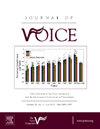COVID-19 住院患者发音障碍严重程度指数和嗓音效果听觉知觉评估共识及其关系。
IF 2.5
4区 医学
Q1 AUDIOLOGY & SPEECH-LANGUAGE PATHOLOGY
引用次数: 0
摘要
研究目的本研究旨在比较COVID-19住院患者和健康受试者的发音障碍严重程度指数(DSI)和嗓音听觉知觉评估共识(CAPE-V)的结果,并探讨DSI和CAPE-V之间的相关性:研究设计:横断面调查:80名受试者参加了此次研究,其中包括40名COVID-19患者(平均年龄为41.2± 5.41)和40名健康受试者(平均年龄为44.50± 3.50)。评估包括用于空气动力声学测量的 DSI 和用于评估听觉知觉嗓音质量的波斯语版嗓音听觉知觉评估 (CAPE-V)。数据采用独立 t 检验和皮尔逊相关分析,显著性水平为 5%:结果显示,COVID-19 患者的 DSI 得分明显低于健康人(P < 0.05)。此外,COVID-19 患者在所有发声类别(严重程度、粗糙度、响度、音调、紧张度和呼吸感)中的得分均高于健康组(P < 0.05)。比较各组的两项嗓音评估结果发现,患病组(r p:-0.68,P:0.001)比健康组(r p:-0.37,P:0.049)存在更大的显著负相关:结论:COVID-19 住院患者的嗓音质量和声学空气动力学特征存在偏差。研究结果还显示,与健康组相比,患者组的感知性发音障碍程度更高,嗓音质量更低。建议开展进一步研究,以确定 COVID-19 患者康复后客观和主观嗓音评估之间的关系。本文章由计算机程序翻译,如有差异,请以英文原文为准。
Dysphonia Severity Index and Consensus Auditory-Perceptual Evaluation of Voice Outcomes, and Their Relation in Hospitalized Patients with COVID-19
Objectives
This study aimed to compare the results of the Dysphonia Severity Index (DSI) and Consensus Auditory-Perceptual Evaluation of Voice (CAPE-V) between patients hospitalized with COVID-19 and healthy subjects, as well as to investigate the correlation between DSI and CAPE-V.
Study design
Cross-sectional survey.
Material and Methods
Eighty subjects, 40 COVID-19 patients (with a mean age of 41.2± 5.41) and 40 healthy subjects (with a mean age of 44.50± 3.50) participated in this study. Assessments included the DSI for aerodynamic-acoustic measurement and the Persian version of Consensus Auditory-Perceptual Evaluation of Voice (CAPE-V) for evaluating auditory-perceptual voice quality. Data were analyzed by means of the independent t-test and Pearson correlation at the 5% significance level.
Results
The results showed COVID-19 patients got significantly lower score in DSI compared to healthy subjects (P < 0.05). Moreover, the patients with COVID-19 had higher scores in all categories of voice production (severity, roughness, loudness, pitch, strain and breathiness) than the healthy group (P < 0.05). Comparing the result of the two voice assessments in each group revealed that there was a greater negative significant correlation in the diseased group (r p: -0.68, P: 0.001) than in the healthy group (r p: -0.37,P: 0.049).
Conclusions
Hospitalized COVID-19 patients experience deviations in the voice quality and acoustic-aerodynamic features of their voice. Also, the results of this study showed the patient group had higher perceptual dysphonia and lower voice quality compared to the healthy group. Further studies are recommended to determine the relationship between objective and subjective voice evaluation in patients with COVID-19 after recovery.
求助全文
通过发布文献求助,成功后即可免费获取论文全文。
去求助
来源期刊

Journal of Voice
医学-耳鼻喉科学
CiteScore
4.00
自引率
13.60%
发文量
395
审稿时长
59 days
期刊介绍:
The Journal of Voice is widely regarded as the world''s premiere journal for voice medicine and research. This peer-reviewed publication is listed in Index Medicus and is indexed by the Institute for Scientific Information. The journal contains articles written by experts throughout the world on all topics in voice sciences, voice medicine and surgery, and speech-language pathologists'' management of voice-related problems. The journal includes clinical articles, clinical research, and laboratory research. Members of the Foundation receive the journal as a benefit of membership.
 求助内容:
求助内容: 应助结果提醒方式:
应助结果提醒方式:


